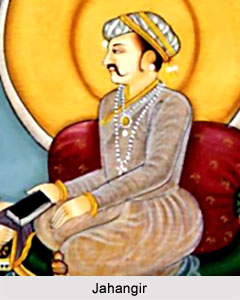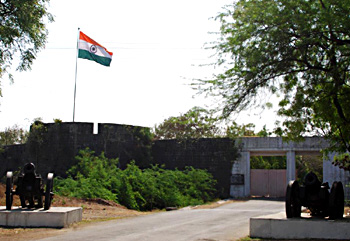 Conquests of Jahangir were mainly directed to those places which were left unconquered by Akbar such as Mewar and south India. Jahangir pursued the policy of the extension of the empire like his father. The conquest of north India was nearly complete during the reign of Akbar. Only a few petty states and Mewar in Rajasthan could maintain their independence. But the conquest of the south was incomplete. Jahangir tried to subdue Mewar and the states in south India. Jahangir desired the submission of Mewar from the beginning of his reign and dispatched prince Parwez to conquer Mewar after his accession to the throne in 1605 A.D. However, the Imperial forces were recalled after some time due I the emergency caused by the revolt of prince Khusrav. Later Jahangir dispatched prince Khurram to subdue Mewar. The Rajputs were hard pressed, their lands were destroyed and their supplies were stopped and the Rana was forced to make peace with the Mughals. The Rana agreed and sent an ambassador to Khurram for settling the terms of the peace. Jahangir gladly accepted the offer of the Rana and a peace was signed between the Mughals and the Rana in 1615 A.D.
Conquests of Jahangir were mainly directed to those places which were left unconquered by Akbar such as Mewar and south India. Jahangir pursued the policy of the extension of the empire like his father. The conquest of north India was nearly complete during the reign of Akbar. Only a few petty states and Mewar in Rajasthan could maintain their independence. But the conquest of the south was incomplete. Jahangir tried to subdue Mewar and the states in south India. Jahangir desired the submission of Mewar from the beginning of his reign and dispatched prince Parwez to conquer Mewar after his accession to the throne in 1605 A.D. However, the Imperial forces were recalled after some time due I the emergency caused by the revolt of prince Khusrav. Later Jahangir dispatched prince Khurram to subdue Mewar. The Rajputs were hard pressed, their lands were destroyed and their supplies were stopped and the Rana was forced to make peace with the Mughals. The Rana agreed and sent an ambassador to Khurram for settling the terms of the peace. Jahangir gladly accepted the offer of the Rana and a peace was signed between the Mughals and the Rana in 1615 A.D.
Jahangir tried to complete the conquest of south India. Akbar had made a beginning towards it. Khandesh and a part of Ahmednagar were conquered during his time. But the conquest of Ahmednagar could not be completed while Golconda and Bijapur were left untouched so far. Jahangir attempted to conquer them. But Malik Ambar, the capable wazir of Ahmednagar succeeded in checking the Mughal expansion towards further south. The primary aim of Malik Ambar was to check further aggression of the Mughals on the territory of Ahmednagar and he succeeded in his attempts. His success saved the rest of the south India from the onslaughts of the Mughals during the reign of Jahangir. The attack of the Mughals under Abdur Rahim in 1608 A.D. failed. In 1610 A.D. Jahangir dispatched a large force under the command of prince Parwez and Asaf Khan to invade Ahmednagar but before its arrival Malik Ambar forced Abdur Rahim to retreat to Burhanpur and sign a peace treaty.
 In 1615 A.D. the Mughals defeated a combined army of Ahmednagar, Bijapur and Golconda near Rosangaon but failed to gain any useful results because of the differences between prince Parwez and Khan-i-Khana. Jahangir dispatched Prince Khurram to the Deccan with a large force and himself reached Mandu in 1617 A.D. The ruler of Bijapur acted as a mediator and efforts were made for a treaty between the Mughals and Ahmednagar. In 1617, the treaty was signed. The territory of Balaghat and a few forts including that of Ahmednagar were surrendered to the Mughals by Ahmednagar and the ruler of Bijapur gave costly presents to prince Khurram. Khurram was given the title of Shah Jahan by Jahangir at this occasion. But the success of the Mughals was in name only. In fact, there was no gain of territory or increase of influence of the Mughals in the Deccan.
In 1615 A.D. the Mughals defeated a combined army of Ahmednagar, Bijapur and Golconda near Rosangaon but failed to gain any useful results because of the differences between prince Parwez and Khan-i-Khana. Jahangir dispatched Prince Khurram to the Deccan with a large force and himself reached Mandu in 1617 A.D. The ruler of Bijapur acted as a mediator and efforts were made for a treaty between the Mughals and Ahmednagar. In 1617, the treaty was signed. The territory of Balaghat and a few forts including that of Ahmednagar were surrendered to the Mughals by Ahmednagar and the ruler of Bijapur gave costly presents to prince Khurram. Khurram was given the title of Shah Jahan by Jahangir at this occasion. But the success of the Mughals was in name only. In fact, there was no gain of territory or increase of influence of the Mughals in the Deccan.
Malik Ambar did not fulfil the terms of the treaty. He entered into an agreement with the states of Bijapur and Golconda and besieged the fort of Ahmednagar in 1620 A.D. He also conquered Berar and its neighbouring territory. Jahangir again deputed Shah Jahan to the campaign of the Deccan. Malik Ambar agreed for peace and a treaty was signed in 1621 A.D. Ahmednagar surrendered not only all that territory which it had captured from the Mughals after the settlement in 1617 A.D. but further territory of its own yielding rupees forty lakhs a year of revenue. Bijapur also paid rupees twelve lakhs and Golconda rupees twenty lakhs to the Mughals. Thus, the Deccan campaign ended in 1621A.D. The campaigns of the Mughals in the Deccan during the reign of Jahangir, in fact, brought not much territorial gain though but of course, pressure on the states of south India increased.
Thus, attempt was made to extend the boundary of the Mughal Empire during the reign of Jahangir. Certainly, a few minor contests were made but the attempt to conquer the south failed. The most remarkable event of the reign of Jahangir, therefore, was the peace treaty with Mewar.



















